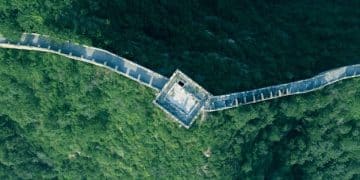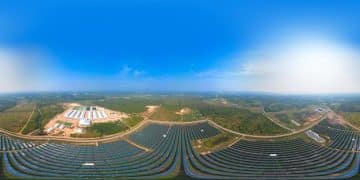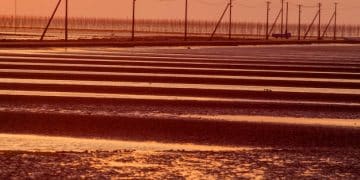Hydropower Advancements: Minimizing Environmental Impact with New Technologies

Hydropower advancements are revolutionizing the energy sector by integrating new technologies that significantly minimize environmental impact, enhancing sustainability and efficiency.
The world’s need for renewable energy sources is more pressing than ever. Among these sources, hydropower has been a long-standing contributor, but traditional methods have raised environmental concerns. Hydropower advancements are now addressing these concerns head-on, employing new technologies to minimize environmental impact and ensure a more sustainable future.
Understanding Hydropower’s Evolution
Hydropower, or hydroelectric power, has been a reliable source of energy for over a century. However, traditional hydropower projects often involved large dams that could disrupt river ecosystems and displace communities. The evolution of hydropower aims to mitigate these adverse effects through innovative technologies and practices.
Traditional Hydropower Challenges
Traditional hydropower plants, while effective, pose several environmental challenges. Large reservoirs can flood vast areas, altering landscapes and impacting biodiversity. The construction of dams can also disrupt fish migration and sediment flow, affecting downstream ecosystems.
The Shift Towards Sustainable Hydropower
The shift towards sustainable hydropower involves a focus on minimizing environmental impact while maintaining energy production. This includes adopting new technologies, implementing better environmental management practices, and considering the social and economic impacts of hydropower projects.
- Environmental Impact Assessments: Conducting thorough assessments before starting any hydropower project to identify potential environmental impacts.
- Fish Passage Technologies: Implementing technologies like fish ladders and elevators to help fish migrate safely around dams.
- Optimized Water Management: Managing water flow to mimic natural patterns and minimize disruption to downstream ecosystems.
Modern hydropower advancements recognize that a balanced approach is essential, one that values both energy production and environmental stewardship. This approach is driving the development and adoption of technologies that reduce the ecological footprint of hydropower.
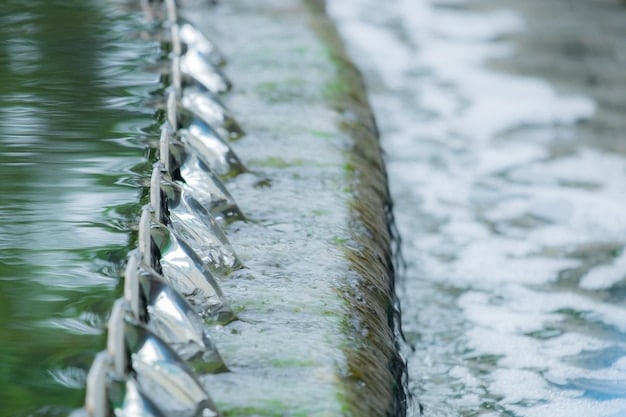
Innovative Technologies in Hydropower
The incorporation of innovative technologies is at the heart of modern hydropower advancements. These technologies range from advanced turbine designs to sophisticated monitoring systems, all aimed at enhancing efficiency and reducing environmental impact.
Advanced Turbine Designs
New turbine designs are more efficient and fish-friendly. For example, Kaplan turbines with improved blade designs reduce the risk of fish injury or mortality as they pass through the turbine. These designs also optimize energy conversion, increasing overall efficiency.
Smart Monitoring Systems
Smart monitoring systems use sensors and data analytics to optimize water flow, predict equipment failures, and monitor environmental conditions. These systems can help operators make informed decisions that balance energy production and environmental protection.
- Real-time Data Analysis: Using real-time data to adjust water flow and turbine operation based on changing environmental conditions.
- Predictive Maintenance: Implementing predictive maintenance programs to identify and address potential equipment failures before they occur.
- Environmental Monitoring: Monitoring water quality, fish populations, and other environmental indicators to assess the impact of hydropower operations.
These innovative technologies are transforming hydropower from a potentially disruptive force into a more harmonious component of the natural environment. By embracing these advancements, hydropower can play a crucial role in achieving a sustainable energy future.
Small-Scale Hydropower Systems
Small-scale hydropower systems offer a viable alternative to large dams, providing clean energy with minimal environmental impact. These systems are particularly suitable for remote communities and off-grid applications.
Run-of-River Hydropower
Run-of-river hydropower plants divert a portion of a river’s flow to generate electricity without creating a large reservoir. This approach minimizes flooding and reduces the impact on river ecosystems. These systems are designed to maintain the natural flow of the river, ensuring minimal disruption to aquatic life.
Micro-Hydropower Solutions
Micro-hydropower systems are even smaller, often generating just a few kilowatts of power. These systems can be used to power individual homes or small communities, providing a sustainable and reliable energy source.
- Minimal Environmental Impact: Reducing the need for large reservoirs and minimizing disruption to river ecosystems.
- Off-Grid Solutions: Providing electricity to remote communities that are not connected to the main power grid.
- Community Ownership: Enabling local communities to own and operate their own hydropower systems.
Small-scale hydropower systems are an important part of the future of renewable energy, offering a decentralized and environmentally friendly approach to power generation. They demonstrate that hydropower can be a sustainable option when implemented thoughtfully and on a smaller scale.
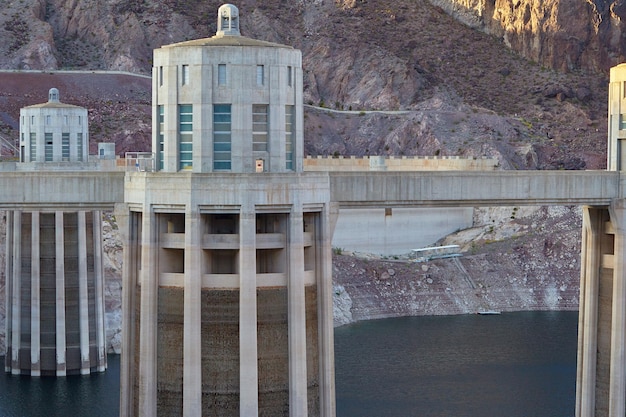
Environmental Benefits of Modern Hydropower
Modern hydropower, with its focus on sustainability and environmental stewardship, offers numerous benefits compared to traditional hydropower and fossil fuel-based energy sources. These benefits extend beyond clean energy production to include ecosystem preservation and climate change mitigation.
Reduced Greenhouse Gas Emissions
Hydropower is a clean energy source that produces no greenhouse gas emissions during operation. This helps reduce the reliance on fossil fuels and mitigate the effects of climate change. The initial construction phase does involve some emissions, but the long-term operational benefits far outweigh these.
Ecosystem Preservation
Modern hydropower projects often include measures to protect and restore river ecosystems. This can include fish passage technologies, optimized water management, and habitat restoration projects. These efforts help ensure that hydropower operations are compatible with the health of the environment.
- Water Quality Improvement: Implementing measures to improve water quality in and around hydropower facilities.
- Habitat Restoration: Restoring degraded habitats to support fish and wildlife populations.
- Sustainable Water Use: Managing water resources sustainably to ensure the long-term availability of water for energy production and other uses.
By prioritizing environmental protection, modern hydropower is demonstrating that energy production and ecological preservation can coexist. This approach is essential for achieving a sustainable energy future that benefits both people and the planet.
Social and Economic Considerations
Hydropower projects have significant social and economic implications, both positive and negative. Modern hydropower development seeks to maximize the benefits while minimizing the adverse impacts on communities and livelihoods.
Community Engagement
Engaging with local communities is crucial for ensuring that hydropower projects are socially responsible. This includes consulting with communities during the planning phase, addressing their concerns, and providing opportunities for participation in the project.
Economic Benefits
Hydropower projects can bring economic benefits to local communities, including job creation, increased tax revenues, and infrastructure improvements. These benefits can help improve the quality of life and promote economic development.
- Job Creation: Creating jobs in construction, operation, and maintenance of hydropower facilities.
- Infrastructure Development: Improving roads, bridges, and other infrastructure in the vicinity of hydropower projects.
- Revenue Generation: Generating tax revenues that can be used to fund local services and programs.
By considering the social and economic impacts of hydropower projects, developers can ensure that these projects contribute to the well-being of communities and promote sustainable development.
The Future of Hydropower
The future of hydropower lies in continued innovation, sustainability, and responsible development. As technology advances and environmental awareness grows, hydropower will play an increasingly important role in the global energy mix.
Integrating with Other Renewables
Hydropower can be integrated with other renewable energy sources, such as solar and wind, to create a more reliable and resilient energy system. Hydropower can provide backup power when solar and wind energy are not available, ensuring a stable supply of electricity.
Policy and Regulation
Supportive policies and regulations are essential for promoting the sustainable development of hydropower. Governments can incentivize the adoption of new technologies, streamline the permitting process, and ensure that environmental and social safeguards are in place.
- Incentives for Innovation: Providing financial incentives for the development and deployment of new hydropower technologies.
- Streamlined Permitting: Simplifying the permitting process for hydropower projects while maintaining environmental and social safeguards.
- Environmental Standards: Establishing clear environmental standards for hydropower operations to protect water resources and ecosystems.
With the right policies and investments, hydropower can continue to evolve and contribute to a sustainable energy future. By embracing innovation and prioritizing environmental stewardship, hydropower can help meet the world’s growing energy needs while minimizing its impact on the planet.
| Key Point | Brief Description |
|---|---|
| 💧 Advanced Turbines | Fish-friendly designs increase efficiency and reduce harm to aquatic life. |
| 📊 Smart Monitoring | Real-time data ensures optimized water flow and environmental protection. |
| 🏞️ Run-of-River | Minimal reservoir impact, supporting natural river flow and ecosystems. |
| 🌱 Ecosystem Focus | Prioritizes habitat restoration and sustainable water use. |
Frequently Asked Questions
▼
Advanced turbine designs, like Kaplan turbines with improved blades, minimize the risk of fish injury. Fish passage systems, such as fish ladders, also help fish migrate safely around dams, reducing mortality rates.
▼
Run-of-river hydropower involves diverting a portion of a river’s flow to generate electricity without creating a large reservoir. This minimizes flooding and reduces the impact on river ecosystems, maintaining the natural flow of the river.
▼
Smart monitoring systems use real-time data to optimize water flow, predict equipment failures, and monitor environmental conditions. This allows operators to make informed decisions that balance energy production and environmental protection.
▼
Hydropower projects can bring economic benefits to local communities, including job creation in construction and maintenance, increased tax revenues, and infrastructure improvements, contributing to overall economic development.
▼
Hydropower can be integrated with other renewable energy sources like solar and wind to create a more reliable grid. It provides backup power when solar and wind are unavailable, ensuring a stable and sustainable electricity supply.
Conclusion
The journey of hydropower advancements towards minimizing environmental impact is marked by technological innovation, sustainable practices, and a commitment to social responsibility. As we look to the future, the integration of hydropower with other renewables and the implementation of supportive policies will be crucial in realizing its full potential as a clean and reliable energy source.

